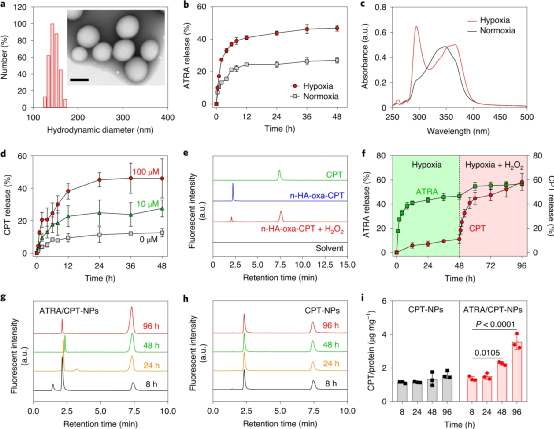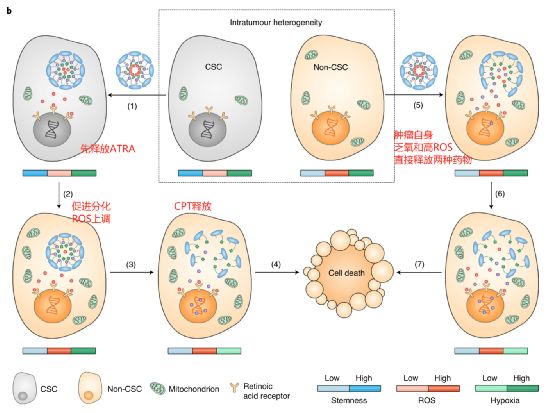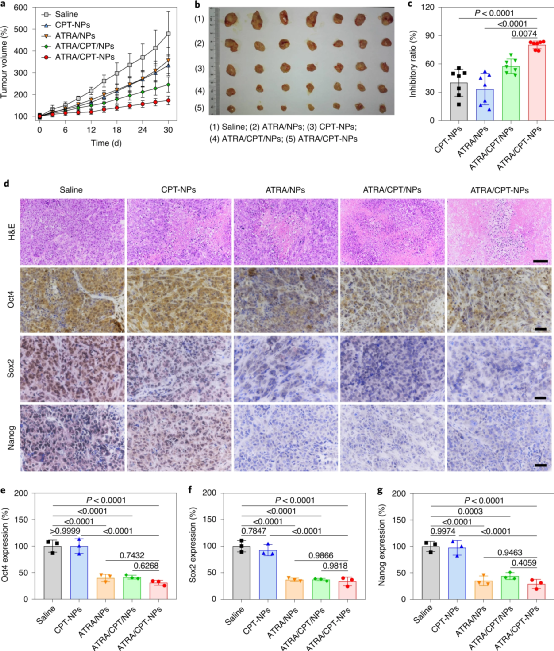China National Pharmaceutical University, this years first Nature Nanotechnology!
QQ Academic Group: 1092348845
Detailed
Tumor heterogeneity has brought persistent obstacles to cancer treatment. It describes a solid tumor containing a variety of cells with different phenotypic characteristics and different sensitivities to treatment. Cancer stem-like cells (CSCs), also known as tumor-initiating cells, have the characteristics of self-renewal, high tumorigenicity, invasiveness, and resistance to traditional chemotherapy and radiotherapy. They are tumor heterogeneity. One of the decisive factors. The existence of cancer stem cells is the chief culprit in the progression, recurrence and metastasis of many malignant tumors. As a typical undifferentiated cancer cell phenotype, CSCs are also significantly higher than well-differentiated tumors in poorly differentiated tumors with high malignancy and poor prognosis. Researchers have made considerable efforts to develop promising anti-CSC strategies, including blocking surface biomarkers and inhibiting self-renewal signaling pathways.
At present, there is a kind of differentiation therapy in the clinic, which induces malignant cells to differentiate into more mature phenotypes with fewer stem cell-like undifferentiated states by using differentiation inducers that are less toxic than conventional chemotherapy drugs. Its hallmark result is the application of all-trans retinoic acid (ATRA) and arsenic to induce complete remission in patients with acute promyelocytic leukemia. More and more evidence confirms that differentiation therapy can reduce the proportion of CSC in various solid tumors.
However, the differentiation treatment of solid tumors has the problem of tumor size not shrinking and a large number of tumor cells remain. Then, combined differentiation therapy and chemotherapy are expected to achieve simultaneous elimination of tumor cells and tumor stem cells. However, considering their unique anti-cancer mechanisms, the improved strategy of co-delivery of differentiation inducers and chemotherapeutic agents is still difficult to achieve the best combined efficacy.
Introduction
Here, Professor Mo Ran from China Pharmaceutical University and others reported a nano-therapeutic strategy that uses nanoparticles co-loaded with the differentiation inducer all-trans retinoic acid and the chemotherapy drug camptothecin to kill CSC in tumors , Which can reduce the drug resistance related to dryness, thereby enhancing the chemotherapy response, inhibiting tumor growth, and preventing tumor recurrence and metastasis after surgery. The results were published on Nature Nanotechnology with the title "A nanotherapeutic strategy to overcome chemotherapeutic resistance of cancer stem-like cells".
Polymer-drug conjugates for sequential drug release
The researchers chose ATRA and CPT as models to induce differentiation and cytotoxic drugs, respectively. Through sequential drug release, the synergistic effect is maximized. That is, firstly, ATRA needs to be released from the nanocarrier to induce CSC to differentiate into non-CSC, and its dryness and chemoresistance are reduced, which increases the sensitivity of CSCs to CPT released subsequently, and prevents the effect of CPT on stem cells. Up. Here, the researchers synthesized a polymer-drug conjugate, the nitroimidazole-modified hyaluronic acid-oxa-CPT conjugate (n-HA-oxa-CPT), which can be assembled into nano Particles and physically encapsulate ATRA to obtain ATRA/CPT-NP.

Figure | Composition and structure of ATRA / CPT-NP

Figure | Preparation and characterization of ATRA/CPT-NP
The role of nanomedicine in cells is roughly the following three main points:
1) Hypoxia induced ATRA release
In the process of CSC differentiation, ATRA/CPT-NP can adaptively distinguish the release of two drugs. First, after ATRA/CPT-NPs are taken up by CSCs, the structure changes from hydrophobic nitroimidazole group to hydrophilic aminoimidazole group caused by hypoxia, and ATRA is rapidly released. The released ATRA acts on the retinoic acid receptor, thereby inducing CSC differentiation.
2) Low ROS, CPT does not release
CSC has a low ROS level due to the increased expression of free radical scavengers, while CPT bound by ROS-labile oxalate bonds is highly stable in undifferentiated CSC and minimally leaks from ATRA/CPT NP, which avoids CSC The efflux of CPT and the increase of CSC stem cells induced by CPT.
3) High degree of differentiation, increased ROS, and CPT release
When CSCs differentiate, due to the increase of mitochondrial biogenesis, the level of intracellular ROS increases with the production of mitochondrial superoxide, which is positively correlated with the degree of differentiation. The increased ROS level leads to the degradation of the oxalate linker, which leads to the release of CPT as the original drug molecule, and enhances the cytotoxicity to differentiated progeny cells, reducing the dryness and resistance. On the contrary, after being endocytosed by a large number of hypoxic tumor cells with higher ROS levels, CPT is released rapidly to cause cell death, and the release of ATRA also promotes the death of CPT.

Figure | How to release the drug
The drug combination shows a more effective effect in eliminating a large number of tumor cells. In addition, the released CPT can enhance the chemotherapy response by inhibiting hypoxia-inducible factor-1α (HIF-1α), thereby alleviating tumor hypoxia. The researchers showed that ATRA/CPT-NPs effectively inhibited the growth, recurrence and metastasis of CSC-rich heterogeneous breast tumors in mouse models.

Figure | The in vivo combination of ATRA/CPT-NPs inhibits the growth of primary tumors
summary:
Through nanoparticle-mediated combined administration of differentiation-inducing drugs and chemotherapeutic drugs, a nano-therapeutic strategy has been developed to overcome treatment obstacles related to intratumoral heterogeneity. The obtained ATRA/CPT nanoparticles unify the pharmacokinetics of the two drugs and maintain a fixed synergistic drug ratio during the cycle. In addition, ATRA/CPT-NPs can adaptively adjust the release characteristics of ATRA and CPT in different cell phenotypes (including CSCs and non-CSCs) by responding to specific cell biological signals. This differential release satisfies the need to promote the maximum synergistic anti-cancer efficacy of the two drugs. The two drugs have different mechanisms of action. They can simultaneously eliminate the treatment-resistant tumor stem cells and large tumor cells to suppress the rich tumor stem cells. Tumor growth, recurrence, and metastasis in the most recent breast tumor model. These findings provide a promising prospect for exploring nano-therapeutic methods to overcome CSC-related chemotherapy resistance.
references:
Shen, S., Xu, X., Lin, S. et al. A nanotherapeutic strategy to overcome chemotherapeutic resistance of cancer stem-like cells. Nat. Nanotechnol. 16, 104–113 (2021). https://doi. org/10.1038/s41565-020-00793-0
Source of information: Wonders
This information is from the Internet for academic exchanges. If there is any infringement, please contact us and delete it immediately
At present, there is a kind of differentiation therapy in the clinic, which induces malignant cells to differentiate into more mature phenotypes with fewer stem cell-like undifferentiated states by using differentiation inducers that are less toxic than conventional chemotherapy drugs. Its hallmark result is the application of all-trans retinoic acid (ATRA) and arsenic to induce complete remission in patients with acute promyelocytic leukemia. More and more evidence confirms that differentiation therapy can reduce the proportion of CSC in various solid tumors.
However, the differentiation treatment of solid tumors has the problem of tumor size not shrinking and a large number of tumor cells remain. Then, combined differentiation therapy and chemotherapy are expected to achieve simultaneous elimination of tumor cells and tumor stem cells. However, considering their unique anti-cancer mechanisms, the improved strategy of co-delivery of differentiation inducers and chemotherapeutic agents is still difficult to achieve the best combined efficacy.
Introduction
Here, Professor Mo Ran from China Pharmaceutical University and others reported a nano-therapeutic strategy that uses nanoparticles co-loaded with the differentiation inducer all-trans retinoic acid and the chemotherapy drug camptothecin to kill CSC in tumors , Which can reduce the drug resistance related to dryness, thereby enhancing the chemotherapy response, inhibiting tumor growth, and preventing tumor recurrence and metastasis after surgery. The results were published on Nature Nanotechnology with the title "A nanotherapeutic strategy to overcome chemotherapeutic resistance of cancer stem-like cells".

Polymer-drug conjugates for sequential drug release
The researchers chose ATRA and CPT as models to induce differentiation and cytotoxic drugs, respectively. Through sequential drug release, the synergistic effect is maximized. That is, firstly, ATRA needs to be released from the nanocarrier to induce CSC to differentiate into non-CSC, and its dryness and chemoresistance are reduced, which increases the sensitivity of CSCs to CPT released subsequently, and prevents the effect of CPT on stem cells. Up. Here, the researchers synthesized a polymer-drug conjugate, the nitroimidazole-modified hyaluronic acid-oxa-CPT conjugate (n-HA-oxa-CPT), which can be assembled into nano Particles and physically encapsulate ATRA to obtain ATRA/CPT-NP.

Figure | Composition and structure of ATRA / CPT-NP

Figure | Preparation and characterization of ATRA/CPT-NP
The role of nanomedicine in cells is roughly the following three main points:
1) Hypoxia induced ATRA release
In the process of CSC differentiation, ATRA/CPT-NP can adaptively distinguish the release of two drugs. First, after ATRA/CPT-NPs are taken up by CSCs, the structure changes from hydrophobic nitroimidazole group to hydrophilic aminoimidazole group caused by hypoxia, and ATRA is rapidly released. The released ATRA acts on the retinoic acid receptor, thereby inducing CSC differentiation.
2) Low ROS, CPT does not release
CSC has a low ROS level due to the increased expression of free radical scavengers, while CPT bound by ROS-labile oxalate bonds is highly stable in undifferentiated CSC and minimally leaks from ATRA/CPT NP, which avoids CSC The efflux of CPT and the increase of CSC stem cells induced by CPT.
3) High degree of differentiation, increased ROS, and CPT release
When CSCs differentiate, due to the increase of mitochondrial biogenesis, the level of intracellular ROS increases with the production of mitochondrial superoxide, which is positively correlated with the degree of differentiation. The increased ROS level leads to the degradation of the oxalate linker, which leads to the release of CPT as the original drug molecule, and enhances the cytotoxicity to differentiated progeny cells, reducing the dryness and resistance. On the contrary, after being endocytosed by a large number of hypoxic tumor cells with higher ROS levels, CPT is released rapidly to cause cell death, and the release of ATRA also promotes the death of CPT.

Figure | How to release the drug
The drug combination shows a more effective effect in eliminating a large number of tumor cells. In addition, the released CPT can enhance the chemotherapy response by inhibiting hypoxia-inducible factor-1α (HIF-1α), thereby alleviating tumor hypoxia. The researchers showed that ATRA/CPT-NPs effectively inhibited the growth, recurrence and metastasis of CSC-rich heterogeneous breast tumors in mouse models.

Figure | The in vivo combination of ATRA/CPT-NPs inhibits the growth of primary tumors
summary:
Through nanoparticle-mediated combined administration of differentiation-inducing drugs and chemotherapeutic drugs, a nano-therapeutic strategy has been developed to overcome treatment obstacles related to intratumoral heterogeneity. The obtained ATRA/CPT nanoparticles unify the pharmacokinetics of the two drugs and maintain a fixed synergistic drug ratio during the cycle. In addition, ATRA/CPT-NPs can adaptively adjust the release characteristics of ATRA and CPT in different cell phenotypes (including CSCs and non-CSCs) by responding to specific cell biological signals. This differential release satisfies the need to promote the maximum synergistic anti-cancer efficacy of the two drugs. The two drugs have different mechanisms of action. They can simultaneously eliminate the treatment-resistant tumor stem cells and large tumor cells to suppress the rich tumor stem cells. Tumor growth, recurrence, and metastasis in the most recent breast tumor model. These findings provide a promising prospect for exploring nano-therapeutic methods to overcome CSC-related chemotherapy resistance.
references:
Shen, S., Xu, X., Lin, S. et al. A nanotherapeutic strategy to overcome chemotherapeutic resistance of cancer stem-like cells. Nat. Nanotechnol. 16, 104–113 (2021). https://doi. org/10.1038/s41565-020-00793-0
Source of information: Wonders
This information is from the Internet for academic exchanges. If there is any infringement, please contact us and delete it immediately
- Previous: [Catalysis] Regulate p
- Next: IF 55.8! Toward Effici


 Academic Frontier
Academic Frontier
